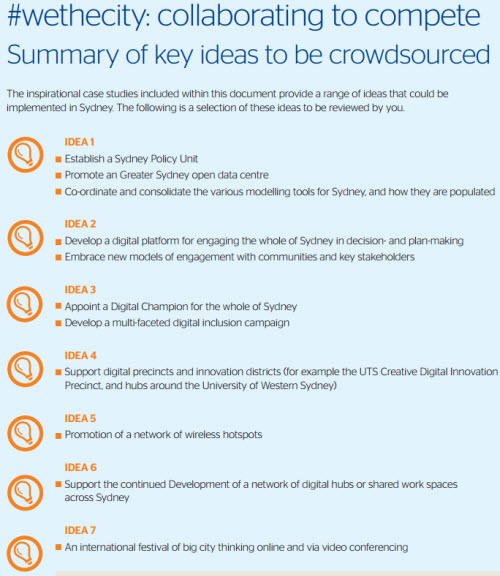Metropolitan IQ and Urban metabolism: Great case studies of innovative, collaborative cities
Last week I went to the launch of an excellent issues paper created by The Committee for Sydney, titled #wethecity: Collaborating to Compete in the Digital Era.
Lucy Turnbull, chair of Committee of Sydney, notes in her opening comments that:
Cities are collaborating to compete and the ones that collaborate most compete best.
The paper focuses on the challenges and opportunities for Sydney, with the summary recommendations at the bottom of this post.
However to understand how innovative cities can be designed, the paper notes that [Leading cities] invest in the art and practice of what we could describe as “systematic serendipity”.
It draws on 16 excellent case studies of how to develop “metropolitan IQ” and a healthy “urban metabolism” (analogies I of course love), including both international and Australian examples. These are summarized below and described in detail in the paper:
Case Study 1: New York – Chief Digital Officer – how NYC’s first CDO is driving digital innovation in the city
Case Study 2: UK – Digital Inclusion Champion – a specific role to give the public greater computer literacy and access
Case Study 3: San Francisco – A “civic accelerator” that taps local entrepreneurs to drive innovation back into the city’s governing processes and systems
Case Study 4: Boston – An Office for New Urban Mechanics as innovation platform for improved urban governance
Case Study 5: Busan, South Korea – Open data to create a city ‘App Store’
Case Study 6: Amsterdam – Smart work centres and technology infused services
Case Study 7: Melbourne – Wiki for Future Melbourne planning, unconferences and CityLab
Case Study 8: Chattanooga – Investment in gigabit broadband for innovative city management including traffic and energy
Case Study 9: Barcelona – An urban regeneration knowledge and innovation precinct
Case Study 10: Portland – Planning to support the unleashing of the 21st Century economy with initiatives including crowdfunding
Case Study 11: Adelaide – Start with what you love and collaborate across boundaries
Case Study 12: NSW – State Government building strategies for innovation, smart work and networks
Case Study 13: UTS/South Sydney – Creative Digital Innovation Precinct
Case Study 14: City of Sydney & Partners – Supporting start-ups and innovation and engaging apps
Case Study 15: ParraConnect – A community led initiative which aims to foster new digital initiatives in the local public sphere
Case Study 16: Sydneysiders doing it for themselves – SuperSydney, CrowdShare and more
In the spirit of collaboration the Committee for Sydney provides a list of 7 ideas to be crowdsourced – putting them forward for Sydney’s citizens to engage with.

The core ideas of the paper – using collaboration to design innovative cities – are immensely relevant. It takes excellent case studies and a great framework to provide insight not just for Sydney, but for any city around the world to drive value for their residents and local economies.
As full disclosure I should note that I was acknowledged in the paper for providing some ideas and input to its development.
